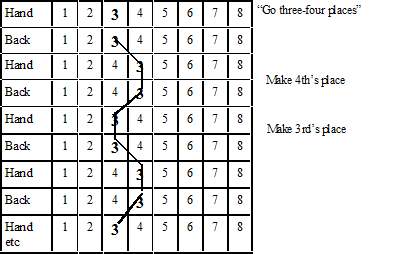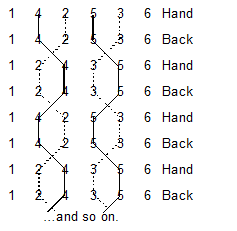Central Council Education Committee
 Learning Together - 3
Learning Together - 3
Making places tidily.
by Peter Dale
Very few ringing books, if any, tackle the problems of a band of ringers who have no experience base to draw upon, and whose captain may not have progressed far beyond the learner stage. These articles suggest to such a band of novice ringers how they may make some progress by their own efforts. Since the conventional approach is of limited help in these cases, some unconventional thinking is needed.
The first article (RW 5 Aug 2011) stressed the importance of a good handling style, and accurately struck rounds before attempting any changes. Last time (RW 9 Dec 2011) the emphasis was upon taking very small steps on the path of progress, simply swapping a pair of bells, calling them back into rounds, and repeating this until the changes are made cleanly without clipping or hesitation. There’s also explanation of place, and how to change places in pages 76 to 78 of The New Ringer’s Book1.
Place changing like this is a good a “warm-up” exercise, but it can soon become tedious even for novices. To sustain interest, without pushing the band too far, use the technique in some simple call changes. Variety can also be achieved by giving learners the chance to master the swapping technique on every bell in the tower up to their weight limit. Make the calls more frequently as the striking improves, but be prepared to reduce the frequency if accuracy begins to suffer.
When ringers are able to move between places without clipping or hesitation then they are ready for their first small step towards change ringing, but first give them some theory. Explain that swapping adjacent pairs of bells is fundamental to change ringing and that you are laying the foundation for things to come. Tell the learners that when a bell is moved into a place, strikes two or more blows there, and then moves out of that place, we say that it “makes the place”. There’s no harm in introducing jargon at this early stage because, apart from economy of expression, the terms must become familiar to a beginner before they tackle method ringing.
These three fundamental exercises will be considered in this and subsequent articles. From left to right, each demands a higher level of bell control than the previous one.

The exercises are continuous and carry on until the conductor calls the bells involved to stop. Some ideas for developing these elementary routines can be found in Gordon Lucas’ book Kaleidoscope Ringing2 in which he analyses the basic skills needed for effective method ringing. Dodging, however, is the most difficult of the three and later articles in this series will look at what actually is a dodge, and the skills required to perform a dodge properly. The aim at this stage is to master Place Making.
As the striking improves, increase the frequency of calls until the ringers are proficient enough to change place accurately at every other hand stroke. Let them know that they are so good at swapping that they could probably do it without the calls. Although this is a very simple step forward, it’s a significant one. Instead of calling each change, a single command sets them off ringing Long Places continuously, until called to stop. If the band is quite confident about this, it may be possible to skip the Long Places altogether and start directly with Places.
Suppose the beginner is ringing the 3rd bell:

Ensure that he or she understands the following:
- The call will be “Go three-four places”.
- It will be called at a hand stroke.
- The move “up” to 4th’s place will be at the next hand stroke, using skills already acquired to swap with the 4th bell.
- “Making 4th’s place” is ringing a whole pull (hand and back) in 4th’s place.
- The move “down” to 3rd’s place is at the next hand stroke, again using familiar skills.
- “Making 3rd’s place” gives a whole pull in rounds.
- Stages 3 to 6 are to be repeated until the conductor calls “that’s all”.
Some teaching points:
- Ideally, let the learner stand behind someone to see how it is done before they try it themselves.
- Choose one of the more capable ringers to make the places with the learner.
- Place a ringer who can lead steadily on the treble.
An inexperienced band can master “Place Making” like this quite quickly, and of course success feeds a sense of achievement. When everyone in the band is familiar with the technique, two or more pairs of bells could make places simultaneously.
Taking this a little further, combine Place Making with some simple call changes:

In this example the bells were first called into Tittums by swapping 3 & 4, 4 & 2, and 5 & 3. The calls are then “Go 2-3 places” followed by “Go 4-5 places”. This will need a theory session on the white board beforehand, but it certainly reinforces the concept of place.
Another variation could have one of the pairs making Long Places. If the changes are made cleanly and confidently, this can sound much more interesting on a Sunday than hesitant call changes.
1 The New Ringer's Book
John Harrison, Catherine Lewis (2009, CC), £9.50, ISBN 978-0-900271-93-9.
2 Kaleidoscope Ringing - a Change Ringer's Alternative to Called Changes
Gordon I Lucas (2004, CC), £2.00, ISBN 0-900271-77-9.
Both Central Council Publications available from Mrs B Wheeler, 2 Orchard Close, Morpeth, NE61 1XE.
